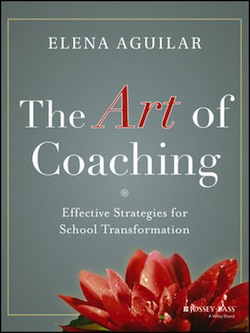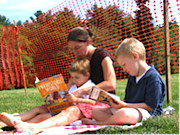A Coach of My Own
The Art of Coaching: Effective Strategies for School Transformation
by Elena Aguilar
(Wiley/Jossey Bass, 2013 – Learn more)
Having Elena Aguilar’s The Art of Coaching in my bag has been like having my own coach nearby.
Just as no practiced coach would try to tackle everything at once, I don’t recommend trying to devour this book in a single sitting, or even a single week. Each section in this substantial four-part book is like a coaching cycle, and each chapter within those sections is like a handful of coaching sessions. Aguilar poses pointed questions and offers multiple illustrations from her own coaching experiences. It takes time to digest each of these. To give the book its due, I feel as though I’d need to return to it over the span of an entire year.

Another useful feature is the shaded box for administrators. These boxes indicate when the upcoming information may be useful to administrators in their roles as growth leaders. Still other shaded boxes highlight key points essential to the topic at hand. Aguilar’s appendices are also valuable as a quick reference to the coaching lenses and sentence stems for coaching conversations. There’s even a transformational coaching rubric that we might want to flip open at a moment’s notice.
Valuable to coaches in every setting
Initially I felt as though Aguilar may be using more words than strictly necessary to convey her point, but as I read beyond the first chapter her voice became increasingly conversational and inviting. Honestly, I’m not sure if her voice changed or if my ability to hear her altered as it might in a true coaching session.
I initially anticipated a distance between her work and my own, because my suburban experience has been so different from the kind of urban environment that Aguilar references. Yet I soon found that I shared her view of coaching as a transformative experience with the possibility of helping not only a teacher, but the education profession to become something more than it is.
At first I shrugged off the coaching lens of “systemic oppression” because it seemed far removed from the schools in which I’ve taught. But as I read the framing questions, I saw it had relevance for any school or system. The questions probe where the power resides. Feelings of agency or powerlessness can exist regardless of racial or socioeconomic diversity. And building an individual’s agency is key to building their capacity.
There IS more to it!
The coaching that Aguilar describes and provides touches on the central facets of the coaching role: building relationships and trust, developing a coaching plan, coaching activities, and conversations for different models of coaching including directive and facilitative. Her book addresses precisely the areas of my coaching in which I felt this year that “there must be more to it.” There is! And Aguilar has laid it out from beginning to end.
I will gladly carry this book with me through my second year as a coach. I have given myself permission to begin from where I am, but this will be the resource that helps me move forward.
Katie Gordon just completed her first year as an elementary reading consultant and coach in Southbury, CT, splitting her time between building the reading capacity of students and the teaching capacity of colleagues. She writes: “I come to coaching from 10 years in middle and high school classrooms, during which time I struggled to find the answers for the challenges my own students were facing. Their struggles led me to read copiously and eventually enroll in a sixth year program in reading.”




































